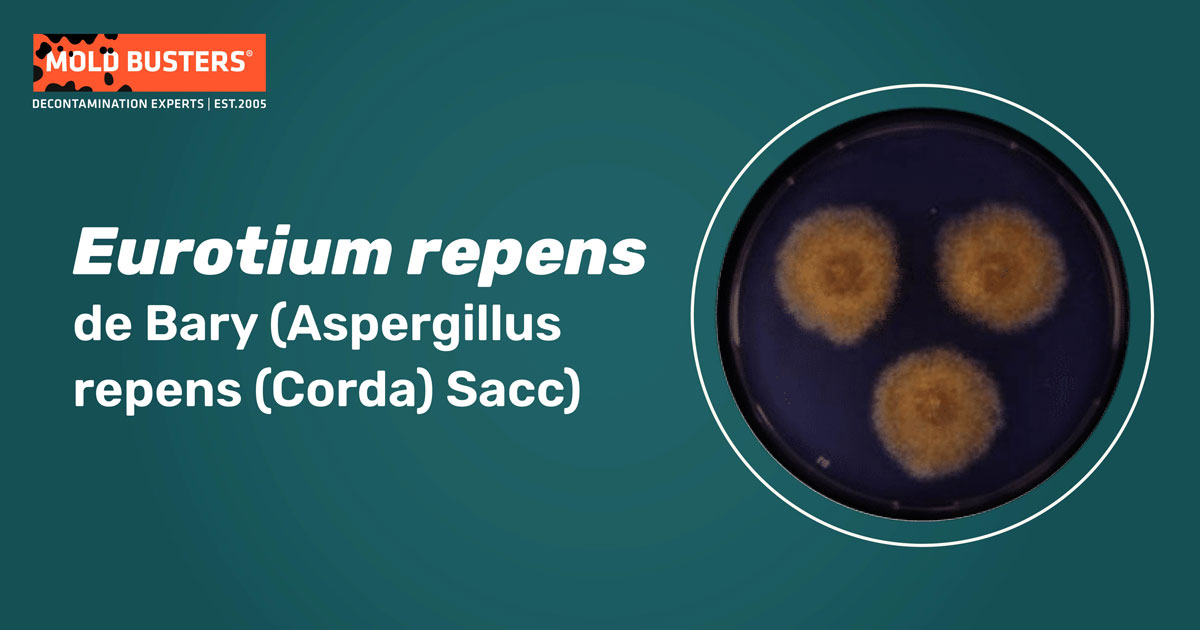de Bary (Aspergillus repens (Corda) Sacc)
What is Eurotium repens?

Eurotium repens is a cosmopolitan ascomycete fungus belonging to the xerophilic genus Eurotium. Xerophilies (Greek xeros – “dry” and philos – “loving”) are one of the seven types of extremophile organisms and can thrive (grow and reproduce) under low-moisture conditions. This makes E. repens a common mold-inhabitant of dried and processed foods and can be commonly found in stored foods such as wheat, barley, corn, and rice. It frequently causes spoiling of salami, meat products, ripening, and cured hams, biltong, salted fish, and katsuobushi. E. repens forms characteristic, barely macroscopic yellow fruiting structures (cleistothecia) with smooth, cellular walls. Apart from processed and dried meats, it can cause spoilage of cheese and cheese products, pecans, corn, rice, and wheat noodles (1,2).
Where can be Eurotium repens be found?
Generally, Eurotium species can survive and grow in high sugar or salt environments (osmotolerance). Some of them (including the E. repens) had been found in waters with salinity above 17% (3). Interestingly, and likely since the E. repens is an osmiophilic and xerophilic species, one study found E. repens to be the primary isolate colonized on the surfaces of the skin and bones of two human corpses. This study aimed to incorporate fungi as forensic tools because the detection of some fungi found in human cadavers may reveal their local habits (4). Eurotium fungi are frequently found in building insulation, dry gypsum walls, composite wood, and ceiling tiles. E. repens might be connected with compounds responsible for the damp and moldy odor of rotting preserved wood. The actions of E. repens microbial metabolism of chlorophenols, found in wood preservatives, creates chloroanisoles that cause the characteristic indoor mold odor, also associated with adverse negative health effects (3,5,6).
Is Eurotium repens dangerous?
Eurotium repens have been confirmed to produce aflatoxins B1 and G1. Aflatoxins are poisonous compounds produced by many mold species. Toxin-producing molds regularly colonize improperly stored staple commodities such as chili peppers, cottonseed, millet, nuts, rice, all types of seed, corn, nuts, spices, and grain. When mold-contaminated foods are processed, the aflatoxins enter the general food supply and poison people and animals. Furthermore, aflatoxin-contaminated cattle feed will cause the eggs, milk, and meat products to contain aflatoxins. These toxins are carcinogens and mutagens, and the Aflatoxin B1 produced by the E. repens is considered the most toxic (7,8).
Eurotium repens reproduction
Aspergillus repens is the asexual state of the organism, while Eurotium repens is the sexual state. During sexual reproduction, mating occurs between two compatible individuals (two sexual state organisms). The resulting offspring will be the product of sexual recombination of the parent genetic materials. In contrast, asexual reproduction implies that a single individual is copying itself through the dispersal of asexual propagules (conidia). This strategy of being able to reproduce without compatible mates is extremely beneficial to all parasites and saprophytes. Sexual reproduction produces new genotypes of the fungus, which can sometimes be hardier or more virulent than their parents. These successful genotypes can then be mass-produced through cloning and dispersed through the asexual conidia (9,10).

Did you know?
Only 12% of tested indoor air quality samples in Canada didn’t have any presence of mold! Find out more exciting mold stats and facts on our mold statistics page.
References
- Pitt JI, Hocking AD. The Ecology of Fungal Food Spoilage. In: Fungi and Food Spoilage. Springer US; 2009.
- Eicher R, Ludwig H. Influence of activation and germination on high-pressure inactivation of ascospores of the mould Eurotium repens. In: Comparative Biochemistry and Physiology – A Molecular and Integrative Physiology. Elsevier Inc.; 2002. p. 595–604.
- Butinar L, Zalar P, Frisvad JC, Gunde-Cimerman N. The genus Eurotium – Members of indigenous fungal community in hypersaline waters of salterns. FEMS Microbiol Ecol. 2005. 51(2):155–66.
- Ishii K, Hitosugi M, Kido M, Yaguchi T, Nishimura K, Hosoya T, et al. Analysis of fungi detected in human cadavers. Leg Med. 2006; 8(3):188–90.
- Lorentzen JC, Johanson G, Juran SA, Ernstgård L, Olsson MJ. Chloroanisoles and chlorophenols explain mold odor but their impact on the swedish population is attributed to dampness and mold. Int J Environ Res Public Health. 2020;17(3).
- Lorentzen JC, Juran SA, Nilsson M, Nordin S, Johanson G. Chloroanisoles may explain mold odor and represent a major indoor environment problem in Sweden. Indoor Air [Internet]. 2016; 26(2):207–18.
- Iqbal SZ, Nisar S, Asi MR, Jinap S. Natural incidence of aflatoxins, ochratoxin A and zearalenone in chicken meat and eggs. Food Control. 2014; 43:98–103.
- El-Kady I, El-Maraghy S, Zohri AN. Mycotoxin producing potential of some isolates of Aspergillus flavus and Eurotium groups from meat products. Microbiol Res. 1994;149(3):297–307.
- McDonald BA, Linde C. The population genetics of plant pathogens and breeding strategies for durable resistance. Euphytica. 2002;124(2):163–80.
- McDonald B. The population genetics of fungi: tools and techniques. Phytopathology. 1997;87(4):448–53.

Get Special Gift: Industry-Standard Mold Removal Guidelines
Download the industry-standard guidelines that Mold Busters use in their own mold removal services, including news, tips and special offers:

Written by:
Dusan Sadikovic
Mycologist – MSc, PhD
Mold Busters
Fact checked by:
Michael Golubev
General Manager
Mold Busters
